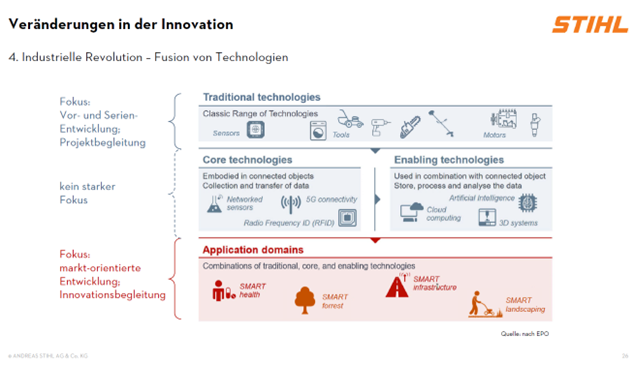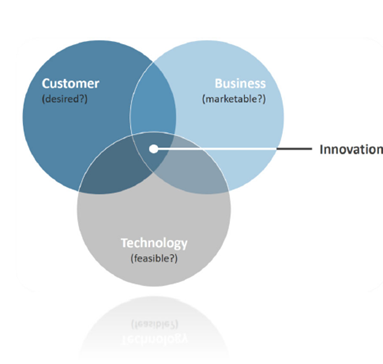IP in the Innovation Process at STIHL
Introduction to STIHL
STIHL is a global leader in motorized tools for forestry, agriculture, landscaping, construction, and private gardening. Renowned for its innovative approach to product development, STIHL has consistently pushed boundaries in technology and design. As a pioneer in chainsaws, the company has evolved into a multinational corporation with a substantial global presence.
- 19,805 Employees Worldwide (2023)
STIHL employs nearly 20,000 individuals across the globe, reflecting its significant scale and commitment to human resource development. These employees contribute to STIHL’s reputation as a leader in innovation and customer satisfaction, working across diverse roles from manufacturing to research and development. The company’s workforce is also highly interdisciplinary, fostering collaboration between experts from various fields to drive innovation. This approach ensures that STIHL remains at the forefront of technological advancements in its industry. - €5.27 Billion in Total Revenue (2023)
In 2023, STIHL achieved an impressive total revenue of €5.27 billion, underscoring its strong market position and financial stability. This success is driven by its commitment to quality products and innovative solutions tailored to customer needs. The company reinvests a significant portion of its revenue into research and development, ensuring continuous improvement and the introduction of cutting-edge technologies across its product range. - Production Facilities in Seven Countries
STIHL operates production facilities in seven countries, enabling it to maintain high standards of quality while meeting global demand efficiently. These facilities are strategically located to optimize logistics and supply chain management. The company’s international production footprint reflects its dedication to sustainability and local economic development, as it integrates eco-friendly practices into its manufacturing processes worldwide. - A Network of Over 55,000 Dealers and Operations in More than 160 Countries
STIHL’s extensive network of over 55,000 dealers ensures that its products are accessible to customers in more than 160 countries. This robust distribution system highlights the company’s global reach and commitment to customer service. By partnering with specialized dealers, STIHL provides expert advice and technical support to customers, enhancing their overall experience with the brand. This dealer network also plays a vital role in maintaining STIHL’s reputation for reliability and innovation.
Innovation at STIHL: A Legacy of Disruption
STIHL’s history is a testament to its pioneering spirit and commitment to innovation, consistently revolutionizing the outdoor power equipment industry. From its earliest invention of the gasoline-powered chainsaw in 1929 to modern advancements in battery technology, STIHL has set benchmarks that shape industry standards. This legacy of innovation reflects the company’s dedication to improving safety, efficiency, and sustainability in forestry and landscaping tools.
- 1929: The First Gasoline-Powered Chainsaw
The introduction of the first gasoline-powered chainsaw marked a pivotal moment in forestry work, replacing manual labor with mechanized efficiency. This groundbreaking invention laid the foundation for STIHL’s reputation as a technological leader in motorized tools. This heavy-duty tool, which initially required two operators, soon evolved into lighter and more ergonomic designs, showcasing STIHL’s ability to adapt and innovate over time. - 1972: Introduction of the Chain Brake for Safety
In 1972, STIHL launched the chain brake system, a revolutionary safety feature designed to reduce injuries caused by kickbacks. This system stops the chain within fractions of a second, significantly enhancing operator safety. The chain brake technology exemplifies STIHL’s dedication to user protection while maintaining high performance standards. It remains a critical feature in modern chainsaws. - 2009: Launch of Battery-Powered Products
Recognizing the growing demand for environmentally friendly solutions, STIHL introduced battery-powered tools in 2009. These products offered quieter operation, zero emissions, and ease of use for both professionals and private users. Since then, STIHL has expanded its battery portfolio to include over 80 models, demonstrating its commitment to sustainability and innovation in power tool technology. - 2022: Development of the Most Powerful Battery Chainsaw
In 2022, STIHL unveiled the MSA 300 C-O, its most powerful battery-powered chainsaw. With advanced features like electronic operating systems and anti-vibration technology, this tool delivers professional-grade performance comparable to gas-powered models. This milestone highlights STIHL’s leadership in integrating cutting-edge battery technology into high-performance equipment for arborists and landscapers. - Focus on Connectivity and Advanced Technologies
Building on its tradition of innovation, STIHL continues to explore new frontiers with technologies such as electronic fuel injection and autonomous tools. These advancements aim to enhance connectivity and sustainability while addressing evolving customer needs.
The Role of Innovation at STIHL
STIHL embraces innovation as a collaborative effort, involving far over 100 employees and students, and experts from 15 different disciplines. This multidisciplinary approach ensures that diverse perspectives and expertise drive the company’s ability to create cutting-edge solutions. By fostering a culture of teamwork and creativity, STIHL positions itself as a leader in developing groundbreaking technologies and products. The company emphasizes team-based innovation processes, where collaboration across departments and roles is central to generating new ideas. This approach not only accelerates problem-solving but also ensures that innovations align with real-world customer needs. Through structured yet flexible processes, STIHL creates an environment where creativity thrives.
A supportive organizational climate is another cornerstone of STIHL’s innovation strategy. The company actively promotes a culture that encourages experimentation and values the contributions of every team member. This nurturing environment helps employees feel empowered to propose bold ideas and explore unconventional solutions. In addition to internal efforts, STIHL adopts open innovation strategies to integrate external expertise into its projects. By collaborating with startups, research institutions, and other partners, the company taps into a broader pool of knowledge and resources. This approach allows STIHL to stay ahead of industry trends and rapidly adapt to emerging technologies.
Through these combined efforts—teamwork, a creative organizational climate, and open innovation—STIHL maintains its reputation as a forward-thinking company that consistently delivers innovative solutions for its customers worldwide.
Adapting to the Fourth Industrial Revolution
The rapid pace of technological transformation has compelled STIHL to redefine its innovation strategies to remain competitive and relevant in a dynamic market. By adapting its approach to align with modern trends, STIHL focuses on creating value through interconnected ecosystems, innovative differentiation, and digital integration.
- Moving from Product Ecosystems to Platform Ecosystems
STIHL has shifted its focus from traditional product ecosystems to platform ecosystems, reflecting the changing dynamics of technological innovation. This transition allows the company to expand beyond standalone products and integrate services, data, and connectivity into comprehensive solutions. By embracing platform ecosystems, STIHL positions itself to address broader customer needs while fostering collaboration across industries. This strategy enhances scalability and creates opportunities for new business models. - Emphasizing Differentiation Through Innovation Rather Than Invention
STIHL prioritizes differentiation through innovation rather than relying solely on invention. This approach focuses on enhancing customer experiences and addressing specific needs by improving existing solutions rather than creating entirely new ones. Through this strategy, STIHL ensures its products stand out in the market by offering unique features and superior performance. It also enables the company to remain agile in responding to evolving demands. - Integrating Digital Transformation Into Their Business Model
Digital transformation is at the core of STIHL’s redefined innovation strategies, enabling the integration of advanced technologies like IoT, AI, and predictive maintenance into its business model. These digital tools enhance operational efficiency and create smarter, more connected products.
By embedding digital transformation into its processes, STIHL not only improves the functionality of its tools but also opens up new revenue streams through services like fleet management and cloud-based solutions.

Challenges in Intellectual Property (IP) Management
STIHL faces several challenges in effectively managing intellectual property (IP) as it adapts to new technological landscapes and business models. These challenges stem from the need to protect enabling technologies, navigate digital ecosystems, and develop cross-domain solutions that align with user-centric approaches. As the company transitions from invention-focused IP strategies to innovation-driven ones, a deep understanding of ecosystems and business scenarios becomes essential.
- One key challenge is identifying protection needs for enabling technologies such as artificial intelligence (AI), connectivity, and performance enhancements. These technologies are integral to STIHL’s innovation processes, offering advanced features and improved product performance. However, their complexity requires careful evaluation to determine which aspects are worth protecting. Early AI concepts and connectivity solutions, for example, demand robust IP strategies to safeguard competitive advantages while fostering technological growth.
- Another challenge lies in adapting to digital ecosystems that incorporate services like predictive maintenance and fleet management. As STIHL integrates connected features into its products, it must address the unique IP needs associated with these digital services. Predictive maintenance tools, for instance, rely on data analytics and cloud-based solutions, which require protection against unauthorized use or replication. Successfully navigating this shift demands a comprehensive approach to securing intellectual property within interconnected systems.
- The third challenge involves developing cross-domain solutions that align with user-centric
 business models.
business models.
These solutions often span multiple industries and require IP strategies that focus on customer needs rather than purely technical aspects. For example, STIHL’s efforts in creating user-driven ecosystems necessitate protecting key elements of the underlying business model while ensuring technical details are adequately safeguarded. This approach emphasizes the importance of understanding customer benefits and market dynamics when crafting IP strategies.
Overall, STIHL’s shift toward innovation-driven IP management reflects its commitment to staying ahead in an increasingly digital and interconnected world. By addressing these challenges with a holistic perspective, STIHL ensures its intellectual property remains a vital asset in supporting its long-term growth and competitive edge.
Integrated Innovation and IP Management at STIHL
STIHL has developed a comprehensive approach to innovation and intellectual property (IP) management, ensuring that its strategies align with technological advancements and market demands. By integrating structured frameworks, forward-looking patent strategies, systemic IP generation, and design futuring, STIHL ensures its leadership in the competitive landscape of motorized tools and connected ecosystems.
- The Innovation Process Framework at STIHL begins with identifying global megatrends and prioritizing those most relevant to its business through annual reviews. This process ensures that the company stays ahead of industry shifts by aligning its innovation efforts with emerging opportunities. Based on these insights, STIHL develops detailed project roadmaps that guide innovations in products, technologies, and business models, creating a clear pathway for long-term growth.
- STIHL’s Patent Strategy combines traditional patent work with forward-looking IP projects to protect its innovations effectively. The company employs tools like trend radars and market scenario analyses to identify valuable IP opportunities, ensuring a proactive approach to safeguarding its competitive edge. This dual focus allows STIHL to balance the protection of current developments while anticipating future market needs, fostering both stability and adaptability in its patent portfolio.
- Through Systemic IP Generation, STIHL adopts a two-pronged approach that addresses both product-focused and business-oriented patents. Product-focused patents are tied directly to specific technological developments, ensuring that innovations are well-protected as they enter the market. Meanwhile, business-oriented patents focus on securing key aspects of future market scenarios, enabling STIHL to shape new industries and maintain a strategic advantage in evolving ecosystems.
- The concept of Design Futuring at STIHL incorporates both market-pull and tech-push strategies to drive innovation. Market-pull strategies derive technologies from customer needs, ensuring that products address real-world challenges effectively. Conversely, tech-push strategies involve applying advanced technologies to STIHL’s application areas, opening up new possibilities for innovation while maintaining relevance in its core markets.
By integrating these elements into a cohesive strategy, STIHL demonstrates its commitment to innovation and IP management as foundational pillars of its success. These efforts not only safeguard the company’s technological advancements but also position it as a leader in shaping the future of its industry.
Reimagining the Role of Patent Departments
Since 2022, STIHL has restructured its patent department to take on a more central role in shaping its future protection strategies. This transformation reflects the company’s commitment to aligning intellectual property (IP) management with its broader innovation goals, ensuring that IP becomes a proactive driver of business success rather than a reactive safeguard. By focusing on patent intelligence, interdisciplinary collaboration, and proactive IP generation, STIHL has positioned its patent department as a key enabler of innovation.
One major focus of this restructuring is the development of strong patent intelligence capabilities. This involves leveraging advanced tools and methodologies to analyze patent landscapes, assess competitive positioning, and identify emerging technological opportunities. By integrating these insights into strategic decision-making processes, STIHL ensures that its IP portfolio not only protects existing innovations but also anticipates future market trends and challenges.
Collaboration across interdisciplinary teams has also become a cornerstone of STIHL’s new approach to IP management. The patent department now works closely with experts from various fields, including engineering, business strategy, and market analysis, to create comprehensive protection strategies. This cross-functional collaboration ensures that IP generation is informed by diverse perspectives, fostering solutions that are both technically robust and commercially viable.
Additionally, STIHL has adopted a proactive stance in steering IP generation processes. Rather than waiting for innovations to emerge organically, the patent department actively identifies areas of strategic importance and guides the development of patents in these domains. This forward-thinking approach not only strengthens STIHL’s competitive edge but also aligns its IP efforts with long-term business objectives.
Through these initiatives—enhanced patent intelligence, interdisciplinary collaboration, and proactive IP management—STIHL’s restructured patent department plays a pivotal role in driving innovation while safeguarding the company’s technological leadership in an increasingly complex and competitive landscape.
Conclusion
STIHL’s integrated approach to innovation and IP management ensures that it remains at the forefront of technological advancements while safeguarding its competitive edge. By aligning business goals with patent strategies and fostering an innovation-friendly culture, STIHL continues to lead in creating impactful solutions for its customers worldwide.



